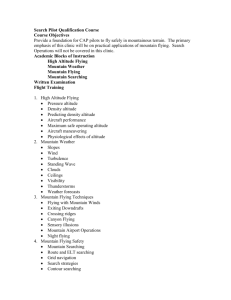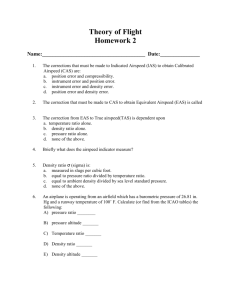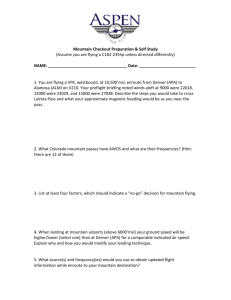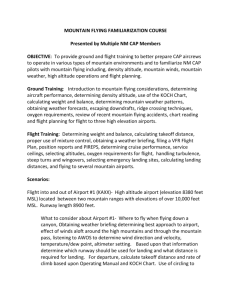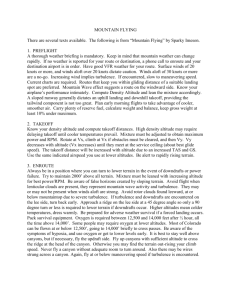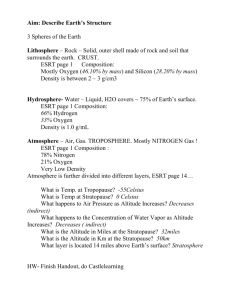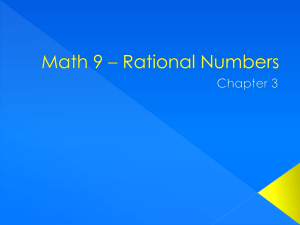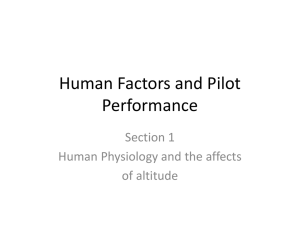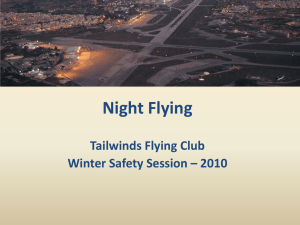QUESTIONS-FOR-MTN-FLY
advertisement
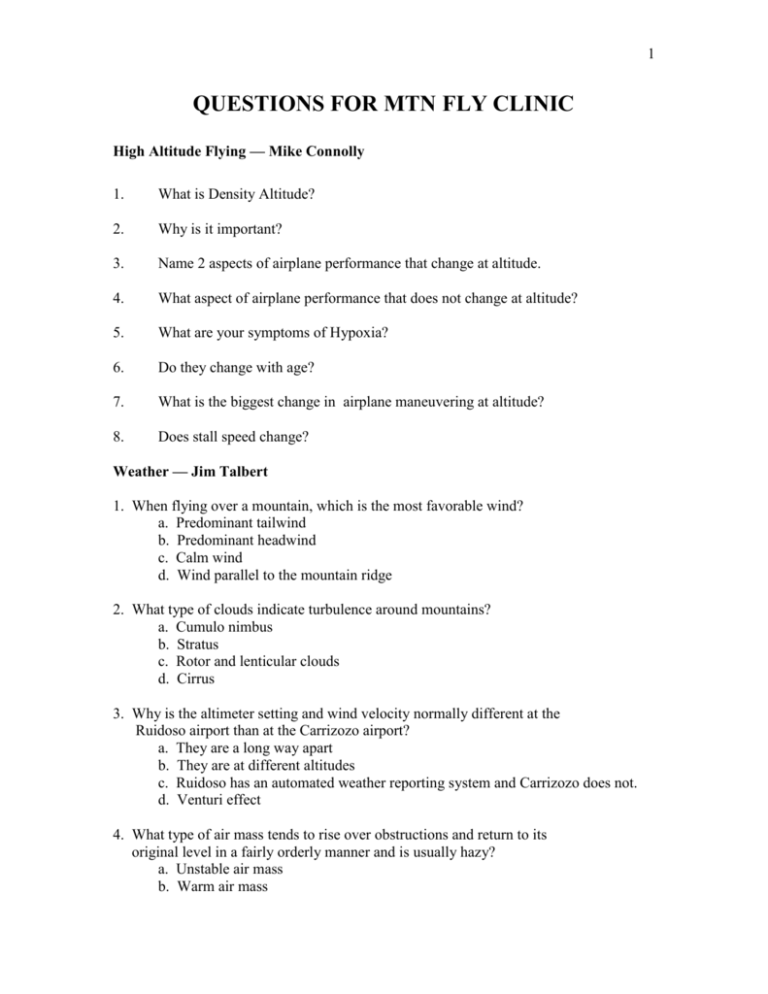
1 QUESTIONS FOR MTN FLY CLINIC High Altitude Flying — Mike Connolly 1. What is Density Altitude? 2. Why is it important? 3. Name 2 aspects of airplane performance that change at altitude. 4. What aspect of airplane performance that does not change at altitude? 5. What are your symptoms of Hypoxia? 6. Do they change with age? 7. What is the biggest change in airplane maneuvering at altitude? 8. Does stall speed change? Weather — Jim Talbert 1. When flying over a mountain, which is the most favorable wind? a. Predominant tailwind b. Predominant headwind c. Calm wind d. Wind parallel to the mountain ridge 2. What type of clouds indicate turbulence around mountains? a. Cumulo nimbus b. Stratus c. Rotor and lenticular clouds d. Cirrus 3. Why is the altimeter setting and wind velocity normally different at the Ruidoso airport than at the Carrizozo airport? a. They are a long way apart b. They are at different altitudes c. Ruidoso has an automated weather reporting system and Carrizozo does not. d. Venturi effect 4. What type of air mass tends to rise over obstructions and return to its original level in a fairly orderly manner and is usually hazy? a. Unstable air mass b. Warm air mass 2 c. Stable air mass d. Adiabatic air mass 5. When approaching a ridge line from the leeward side, what is the best angle to approach the ridge line and why? a. 45 allowing a quick turnaround to lower terrain b. 90 allows a quicker path to cross the mountain c. 45 allows for less turbulence d. 90 allows for more lift crossing the mountain 6. What is a recommended method for a course reversal maneuver when flying in a canyon? a. Use a standard rate turn to maintain maximum lift and best visual lookout b. Use a 60 bank turn c. Use the maximum G-loading that the aircraft POH permits d. Achieve Vx and continue on your route to achieve your TOT Mountain Flying techniques — Zenonian 1. You are landing at TEX (Telluride Regional), field elevation is 9070’. Your IAS for approach at a sea-level airport is 70 knots. What IAS should you fly your approach at TEX? A. 70 knots. Approach speed is not adjusted for changes in pressure altitude. B. 78 knots because of the high density altitude C. 70 knots +5 knots for every 10 knots of crosswind 2. When flying into a mountain airport, compared to an airport at lower elevation, you can expect A. Both landing and takeoff distance to increase B. Takeoff distance to increase more than landing distance will increase C. Landing distance to increase more than takeoff distance will increase D. Both A & B E. Both A & C 3. Since climb gradient is partly a function of ground speed A. Faster aircraft need a lower rate of climb to clear an obstacle in a given distance B. Faster aircraft need a higher rate of climb to clear an obstacle in a given distance C. There is no correlation between ground speed and rate of climb 4. Flying on the windward (upwind) side of a mountain ridge allows pilots to: A. Avoid turbulence B. Avoid gliders that are looking for lift C. See the upcoming terrain and avoid blind canyons D. Use upslope wind to gain altitude 3 5. When flying down a valley with high terrain on each side, you should A. Fly down the middle of the valley to avoid the high terrain B. Fly on the downwind side to avoid updrafts C. Fly down the right side so you have more room to turn around D. Use your landing light so oncoming traffic can see you 6. What is the best technique for crossing a ridgeline? A. Approach the ridgeline at a 45-degree angle B. No special precautions are necessary C. Approach the ridgeline at a 90-degree angle D. Cross the ridgeline with a tailwind 7. Why is it more difficult to make a tight 180-degree turn at high density altitude? A. True airspeed decreases with density altitude thus increasing turn radius B. True airspeed increases with density altitude thus increasing turn radius C. It is not more difficult D. Turn radius is a factor of groundspeed, not true airspeed 8. When might it make sense to take off with a tailwind? A. You should never take off with a tailwind B. If the sun is in your eyes, you can take off with a tailwind C. On a down sloping runway D. If you are flying a tail wheel aircraft E. If the bear you wounded has decided you would make a nice lunch 9. What is the formula for determining the affect of a downwind take-off on ground roll? a. E=MC2 b. L=CL * R * ½V2 * A ∞ c. 𝑓(𝑥) = 𝑎0 + ∑ 𝑛=1 (𝑎𝑛 cos 𝑛𝜋𝑥 𝐿 + 𝑏𝑛 sin 𝑛𝜋𝑥 𝐿 ) d. Add 10% for each two knots of downwind component.
